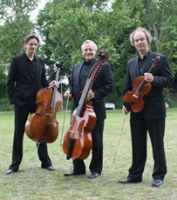
What No Violins?
Violin fanciers were out of luck at Chamber Music Cincinnati's Tuesday evening (April 21) concert in Werner Recital Hall at the University of Cincinnati College -Conservatory of Music.

It was an evening for the lower strings, the viola, the cello and a long lost relative, the baryton.
The Berlin-based Geringas Baryton Trio – David Geringas on baryton, violist Hartmut Rohde and cellist Jens Peter Maintz – performed before a crowd that -- it is probably safe to say -- hardly knew what to expect, but went away delighted and gratified by their new discovery.
Rarely heard or seen since the 18th-century, the baryton is a hybrid viola da gamba (“leg viol” meaning held between the legs like a cello). Cello-sized, it has six strings played with the bow and up to 40 “sympathetic" strings located behind the neck that resonate along with the bowed strings and can be plucked either separately or simultaneously. The baryton has been out of favor since courtly times when kings and princes held musical soirees and had their own court composers.
One of those liveried servants was Haydn, “papa” of the symphony, the string quartet and, incidentally, godfather of the baryton, favorite instrument of his employer Prince Nikolaus Esterhazy of Eisenstadt (a Hungarian princely state, now part of Austria). The Prince played the baryton himself, with Haydn often on viola.
At royal behest, Haydn wrote 126 trios for baryton, viola and cello, a body of work that has virtually assured the survival of the baryton. The Geringas Trio performed two of them: Nos. 97 and 113, both in D Major, plus the Trio in C Major by Luigi Tomasini, concertmaster of Haydn’s Esterhazy orchestra. Making the feast of lower voices even tastier were Beethoven’s Duet for Viola and Cello, “with eyeglasses obbligato,” and Rossini’s Duet for Cello and Bass, transcribed for two cellos.
Tomasini’s three-movement trio made a spirited and attractive opener, introducing the baryton’s bright, somewhat nasal sound. Geringas (one of the world’s greatest and most versatile cellists) topped it off with a flourish of pizzicato on the instrument’s extra strings. There are 12 on his handsome 1982 reproduction by German luthier Hubert Schnorr, with its handsome lion’s head scroll.
To help the audience “get it,” Geringas leaned his baryton forward so they could see his thumb plucking the strings on their own manual behind the neck of the instrument.
Next was Beethoven’s oddly-named two-movement Duet (a comment on the visual acuity of the players for whom he wrote it). One might well need eyeglasses, since it is a workout which Rohde and Maintz took at a fearless clip. They projected abundant musicality and personality, too, with sly nods and sideward glances, plus an occasional toss of the head by the Beatle-maned Maintz.
Haydn’s Baryton Trio No. 113 closed the first half. This gracious and charming work began with a gentle Adagio punctuated by baryton pizzicato. The players’ virtuosity and uncannily precise ensemble were on display throughout as they engaged in a very democratic sharing of roles.
Geringas returned after intermission to perform Latvian composer Peteris Vask’s “Gramata Cellam” (“The Book”) for solo cello in tribute to his friend, violinist Henry Meyer, Holocaust survivor, CCM professor and member of the famed LaSalle Quartet, who died in 2006. Composed in 1978, the work utilizes harmonics, glissandi and wordless singing by the cellist, making a profound impression on the Werner Hall audience.
Geringas stayed on the cello for Rossini’s Duo, performed with Maintz. In three movements and technically daunting, it made quite a showpiece. The second movement was flush with melody, like an opera aria, with even a droplet or two of storm-like music right out of “The Barber of Seville.” The two men exchanged solo/accompaniment roles in mock-heroic fashion in the jaunty finale.
The program closed with Haydn’s 1766 Baryton Trio No. 97, a generous six-movement work written for Prince Esterhazy’s birthday. Haydn the master composer shone brightly here: in the richly thematic Adagio cantabile, in the Polonaise where Rohde gave gentle but pointed expression to the viola fillip at the end of phrases, and in the way the melody line is distributed among the instruments in the Menuet leading into the finale, which is itself a fugue.
There were two encores, adding yet another crescendo to the evening. The first movement of Haydn’s Baryton Trio No. 5, as Geringas noted from the stage, quotes an aria from one of the Prince’s favorite operas (che faro senza Euridice from Gluck’s “Orfeo”). Then it was pure fun – a violist’s revenge – in Paganini’s “Carnival Divertimento” arranged for viola and two cellos by violist Vladimir Mendelssohn.
Violist Rohde took command here, standing to show his chops in every trick from Paganini’s book, including stratospheric high notes, fingered harmonics and left hand pizzicato. He was joined in high good humor by Geringas and Maintz, bringing the show to a rollicking end.